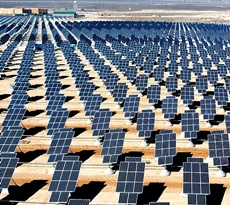Domestic manufacturing of solar panels may help save $42 billion: KPMG report
01 Aug 2014
A government-supported solar panel manufacturing industry could help improve energy security, create jobs and save up to $42 billion in foreign exchange by the year 2030, according to a report jointly prepared by KPMG and the Indian Solar Manufacturers' Association (ISMA).
 Noting that about 100 gigawatts of solar capacity would be established in the country by 2030, the ISMA also calls for continued government support to the sector, which could lead to better energy security and job creation.
Noting that about 100 gigawatts of solar capacity would be established in the country by 2030, the ISMA also calls for continued government support to the sector, which could lead to better energy security and job creation.
"If a sustainable domestic solar manufacturing is promoted, it can save $42 billion in equipment imports by the turn of 2030," the report states.
India annually imports more than $30 billion worth of electronic goods, including solar panels, making it the fourth-largest item in the import basket and contributing to 23 per cent of its trade deficit.
Promotion of solar power equipment manufacturing will also help create 50,000 direct jobs and more than 125,000 indirect jobs over the next five years, according to the report.
The report suggests that if tax and other incentives are given to local manufacturers, the resulting increase in local production would benefit the government by $1.1 billion over the next ten years.
While the national manufacturing policy recognises solar manufacturing to be of strategic importance, the KPMG report said the industry has been going through challenging times in the absence of a level-playing field with global players.
"The domestic solar manufacturing is competitive but suffers due to lack of incentives that are provided to solar manufacturers in other nations. As much as 40 per cent of domestic solar producers have shut down, with the industry utilisation at just 21 per cent," ISMA president Ashwani Sehgal said.
He said that countries which have ambitious solar energy generation plans like China, the USA and Japan strongly support domestic manufacturing through incentives like loans at lower interest rates, credit guarantees, capital subsidies, tax holidays, anti-dumping measures as well as preferential domestic procurement, amongst others.
"While supporting domestic manufacturing could result in moderately higher prices of solar power in the short run, the cost curve would fall in the medium term, as scale and supply chains develop," KPMG's renewable energy head Santosh Kamath said in the report.
Published jointly by Indian Solar Manufacturers' Association (ISMA) and KPMG, the report calls for a holistic policy to encourage domestic solar manufacturing, given the strategic need for solar power in India.





.webp)

.webp)























